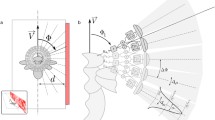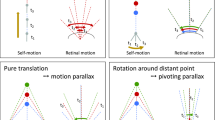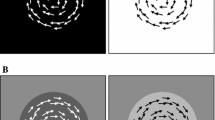Summary
From psychophysics it is known that humans easily perceive motion in Fourier-stimuli in which dots are displaced coherently into one direction. Furthermore, motion can be extracted from Drift-balanced stimuli in which the dots on average have no distinct direction of motion, or even in paradox Θ-motion stimuli where the dots are displaced opposite to the perceived direction of motion. Whereas Fourier-motion can be explained by very basic motion detectors and nonlinear preprocessing of the input can account for the detection of Drift-balanced motion, a hierarchical model with two layers of motion detectors was proposed to explain the perception of Θ-motion. The well described visual system of the fly allows to investigate whether these complex motion stimuli can be detected in a comparatively simple brain.
The detection of such motion stimuli was analyzed for various random-dot cinematograms with extracellular recordings from the motion-sensitive Hl-neuron in the third visual ganglion of the blowfly Calliphora erythrocephala. The results were compared to computer-simulations of a hierarchical model of motion detector networks.
For Fourier- and Drift-balanced motion stimuli, the Hl-neuron responds directionally selective to the moving object, whereas for Θ-motion stimuli, the preferred direction is given by the dot displacement. Assuming nonlinear preprocessing of the detector input, such as a half-wave rectification, elementary motion detectors of the correlation type can account for these results.
Similar content being viewed by others
Abbreviations
- EMD :
-
elementary motion detector
References
Anstis SM (1978) Apparent movement. In: Held R, Leibowitz, HW, Teuber HL (eds) Handbook of sensory physiology: Perception vol VIII. Springer, Berlin Heidelberg New York, pp 655–673
Barlow HB, Levick WR (1965) The mechanism of directionally selective units in rabbit's retina. J Physiol 178:477–504
Bishop LG, Keehn DG, McCann GD (1968) Motion detection by interneurons of optic lobes and brain of the flies Calliphora phaenicia and Musca domestica. J Neurophysiol 31:509–525
Borst A, Egelhaaf M (1989) Principles of motion detection. Trends Neurosci 12:297–306
Braddick OJ (1974) A short-range process in apparent motion. Vision Res 14:519–527
Buchner E, Götz KG, Straub C (1978) Elementary detectors for vertical movement in the visual system of Drosophila. Biol Cybern 31:235–242
Buchner E (1984) Behavioural analysis of spatial vision in insects. In: Ali MA (ed) Photoreception and vision in invertebrates. Plenum Press, New York London, pp 561–621
Chang JJ, Julesz B (1983) Displacement limits, directional anisotropy and direction versus form discrimination in random-dot cinematograms. Vision Res 23:639–646
Chubb C, Sperling G (1988) Drift-balanced random stimuli: A general basis for studying non-Fourier motion perception. J Opt Soc Am 5:1986–2007
Chubb C, Sperling G (1989) Two motion perception mechanisms revealed through distance-driven reversal of apparent motion. Proc Natl Acad Sci USA 86:2985–2989
Collett TS (1980) Angular tracking and the optomotor response. An analysis of visual reflex interaction in a hoverfly. J Comp Physiol 140:145–158
Collett TS, Land MF (1975) Visual control of flight behaviour in the hoverfly Syritta pipiens L. J Comp Physiol 99:1–66
Doorn AJ van, Koenderink JJ (1983) The structure of the human motion detection system. IEEE Trans Syst Man Cybern. 13:916–922
Eckert H (1980) Functional properties of the Hl-neuron in the third optic ganglion of the blowfly, Phoenicia. J Comp Physiol 135:29–39
Egelhaaf M (1985a) On the neuronal basis of figure-ground discrimination by relative motion in the visual system of the fly. I. Behavioural constraints imposed on the neuronal network and the role of the optomotor system. Biol Cybern 52:123–140
Egelhaaf M (1985b) On the neuronal basis of figure-ground discrimination by relative motion in the visual system of the fly. II. Figure-Detection Cells, a new class of visual interneurones. Biol Cybern 52:195–209
Egelhaaf M, Borst A (1989) Transient and steady-state response properties of movement detectors. J Opt Soc Am A 6:116–127
Egelhaaf M, Borst A (1990a) Transient and steady-state response properties of movement detectors: Erratum. J Opt Soc Am A 7:172–172
Egelhaaf M, Borst A (1990b) Is motion detected by the fly visual system in seperate on- and off-cannels? In: Elsner N (ed) Proc 18th Göttingen Neurobiol Conf. Thieme, Stuttgart New York, p 209
Egelhaaf M, Borst A(1991) Are there seperate on- and off-channels in fly motion vision? Visual Neurosci (in press)
Egelhaaf M, Reichardt W (1987) Dynamic response properties of movement detectors: Theoretical analysis and electrophysiological investigation in the visual system of the fly. Biol Cybern 56:69–87
Egelhaaf M, Hausen K, Reichardt W, Wehrhahn C (1988) Visual course control in flies relies on neuronal computation of object and background motion. Trends Neurosci 11:351–358
Franceschini N, Kirschfeld K (1971) Les phenomènes de pseudopupille dans l'oeil composè de Drosophila. Kybernetik 9:159–182
Franceschini N, Münster A, Heurkens G (1979) Äquatoriales und binokulares Sehen bei der Fliege Calliphora erythrocephala. Verh Dtsch Zool Ges p 209
Götz KG (1965) Die optischen Übertragungseigenschaften der Komplexaugen von Drosophila. Kybernetik 2:215–221
Götz KG (1968) Flight control in Drosophila by visual perception of motion. Kybernetik 4:199–208
Grind WA van de, Koenderink JJ T, Doorn AJ van (1986) The distribution of human motion detector properties in the monocular visual field. Vision Res 26:797–810
Gregory RL, Harris JP (1984) Real and apparent movement nulled. Nature 307:729–730
Hassenstein B, Reichardt W (1956) Systemtheoretische Analyse der Zeit-, Reihenfolgen- und Vorzeichenauswertung bei der Bewegungsperzeption des Rüsselkäfers Chlorophanus. Z Naturforsch 11b, 9/10:513–524
Hausen K (1976) Struktur, Funktion und Konnektivität bewegungsempfindlicher Interneurone im dritten optischen Neuropil der Schmeissfliege Calliphora erythrocephala. Doctoral Dissertation, University of Tuebingen,
Hausen K (1982a) Motion sensitive interneurons in the optomotor system of the fly. I. The horizontal cells: structure and signals. Biol Cybern 45:143–156
Hausen K (1982b) Motion sensitive interneurons in the optomotor system of the fly. II. The Horizontal Cells: Receptive field organization and response characteristics. Biol Cybern 46:67–79
Hausen K (1984) The lobula-complex of the fly: Structure, function and significance in visual behaviour. In: Ali MA (ed) Photoreception and vision in invertebrates. Plenum Press, New York London, pp 523–559
Hausen K, Egelhaaf M (1989) Neural mechanisms of visual course control in insects. In: Stavenga D, Hardie R (eds) Facets of vision. Springer, Berlin Heidelberg New York London Paris Tokyo, pp 391–424
Lelkens AMM, Koenderink JJ (1984) Illusory motion in visual displays. Vision Res 24:1083–1090
Mastebroek HAK, Zaagman WH, Lenting BPM (1980) Movement detection: Performance of a wide-field element in the visual system of the blowfly. Vision Res 20:467–474
Mikami A, Newsome WT, Wurtz RH (1986) Motion selectivity in macaque visual cortex. I. Mechanisms of direction and speed selectivity in extrastriate area MT. J Neurophysiol 55:1308–1327
Newsome WT, Mikami A, Wurtz RH (1986) Motion selectivity in macaque visual cortex. III. Psychophysics and physiology of apparent motion. J Neurophysiol 55:1340–1351
Petersik JT, Hicks KI, Pantle A (1978) Apparent movement of successively generated subjective figures. Perception 7:371–383
Poggio T, Reichardt W, Hausen K (1981) A neuronal circuitry for relative movement discrimination by the visual system of the fly. Naturwissenschaften 68:443–446
Quenzer T (1990) Zur visuellen Wahrnehmung paradoxer Bewegungen durch die Fliege. Elektrophysiologische Ableitung am Hl-Neuron von Calliphora erythrocephala. Diplomarbeit der Fakultät für Biologie, Tübingen
Rapf D, Wehrhahn C (1991) Two distinct substrates for motion perception in man. In: Elsner N, Penzlin H (eds) Proc 19th Göttingen Neurobiol Conf. Thieme, Stuttgart New York, p 565
Reichardt W (1957) Autokorrelations-Auswertung als Funktionsprinzip des Zentralnervensystems. Z Naturforsch 12b:448–457
Reichardt W, Varjú D (1959) Übertragungseigenschaften im Auswertesystem für das Bewegungssehen. Z Naturforsch 14b:674–689
Reichardt W (1961) Autocorrelation, a principle for the evaluation of sensory information by the central nervous system. In: Rosenblith WA (ed) Sensory communication. M.I.T. Press and John Wiley & Sons, New York London, pp 303–317
Reichardt W (1987) Evaluation of optical motion information by movement detectors. J Comp Physiol A 161:533–547
Santen JPH van, Sperling G (1985) Elaborated Reichardt detectory. J Opt Soc Am A 2:300–321
Schuling FH, Mastebroek HAK, Bult R, Lenting BPM (1989) Properties of elementary movement detectors in the fly Calliphora erythrocephala. J Comp Physiol A 165:179–192
Wagner H (1986a) Flight performance and visual control of the flight of the free-flying housefly (Musca domestica). II. Pursuit of targets. Phil Trans R Soc Lond B 312:553–579
Wagner H (1986b) Flight performance and visual control of flight of the free-flying housefly (Musca domestica). I. Organization of the flight motor. Phil Trans R Soc Lond B 312:527–551
Wagner H (1986c) Flight performance and visual control of flight of the free-flying housefly (Musca domestica). III. Interactions between angular movement induced by wide- and smallfield stimuli. Phil Trans R Soc Lond B 312:581–595
Wehrhahn C, Reichardt W (1975) Visually induced height orientation of the fly Musca domestica. Biol Cybern 20:37–50
Wehrhahn C, Poggio T, Bülthoff H (1982) Tracking and chasing in houseflies (Musca). Biol Cybern 45:123–130
Zaagman WH, Mastebroek HAK, Buyse T, Kuiper JW (1977) Receptive field characteristics of a directionally selective movement detector in the visual system of the blowfly. J Comp Physiol 116:39–50
Zanker JM (1990) H-motion: A new psychophysical paradigm indicating two levels of visual motion perception. Naturwissenschaften 77:243–246
Zanker JM, Hüpgens IS, Quenzer T (1991) Behavioural response of the fly to Fourier-, driftbalanced and paradox motion stimuli (Theta-motion) In: Elsner N, Penzlin H (eds) Proc 19th Göttingen Neurobiol Conference. Thieme, Stuttgart New York, p 280
Zeil J (1983) Sexual dimorphism in the visual system of flies: The free flight behaviour of male Bibionidae (Diptera). J Comp Physiol 150:395–412
Author information
Authors and Affiliations
Rights and permissions
About this article
Cite this article
Quenzer, T., Zanker, J.M. Visual detection of paradoxical motion in flies. J Comp Physiol A 169, 331–340 (1991). https://doi.org/10.1007/BF00206997
Accepted:
Issue Date:
DOI: https://doi.org/10.1007/BF00206997




